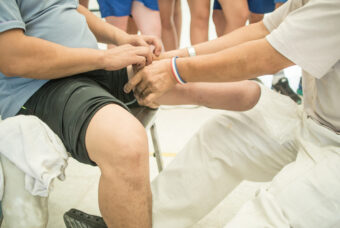 Living with a prosthetic limb can be challenging, especially when it comes to comfort. Many people struggle with discomfort, pain, and irritation caused by their prosthetics, which can greatly impact their quality of life. However, there are several steps you can take to improve the comfort of your prosthetic limb. In this blog, we will explore some practical tips and strategies that can help you enhance your prosthetic comfort and make everyday activities more enjoyable.
Living with a prosthetic limb can be challenging, especially when it comes to comfort. Many people struggle with discomfort, pain, and irritation caused by their prosthetics, which can greatly impact their quality of life. However, there are several steps you can take to improve the comfort of your prosthetic limb. In this blog, we will explore some practical tips and strategies that can help you enhance your prosthetic comfort and make everyday activities more enjoyable.
1. Work closely with your prosthetist
One of the first steps in improving your prosthetic comfort is to work closely with your prosthetist. Your prosthetist is a trained professional who specializes in designing and fitting prosthetic limbs. Communicate openly with them about any discomfort or issues you are experiencing. They can make adjustments to the alignment, socket, or cushioning, ensuring the best possible fit for your prosthetic limb. Regular visits to the prosthetist will help in fine-tuning the fit, improving comfort, and resolving any issues that may arise.
2. Ensure proper sock management
Socks play a vital role in ensuring the comfort of your prosthetic limb. It is important to wear the right type and thickness of socks to achieve a proper fit and reduce friction. Ensure that your socks are clean, dry, and in good condition. Avoid wearing socks with wrinkles or seams that can create pressure points and cause discomfort. Additionally, be mindful of regularly changing your socks throughout the day, especially if you sweat excessively, as moisture can worsen discomfort and potentially cause skin irritation.
3. Practice good skincare
Maintaining healthy skin is crucial for prosthetic comfort. Ensure that your residual limb is clean and dry, as excessive moisture can lead to skin breakdown and discomfort. Cleanse your residual limb daily with mild soap and lukewarm water, patting it dry gently without rubbing. Regularly inspect your skin for any signs of irritation, redness, or pressure sores, and promptly seek medical attention if you notice any issues. Applying a moisturizer, recommended by your prosthetist, can also help keep the skin hydrated and reduce the risk of skin-related discomfort.
4. Consider silicone liners or sleeves
Silicone liners or sleeves can greatly improve prosthetic comfort. Liners provide cushioning, absorb shock, and reduce friction between your residual limb and the prosthetic socket. They are available in various thicknesses and designs to suit individual needs. Silicone sleeves, on the other hand, provide a protective layer over the prosthetic socket, reducing direct contact and preventing potential discomfort. Consulting your prosthetist to explore the different liner or sleeve options and determining the best choice for your specific situation is highly recommended.
5. Incorporate proper prosthetic limb care
Proper care and maintenance of your prosthetic limb can also contribute to enhanced comfort. Regularly inspect the components for any signs of wear or damage, such as loose screws or worn-out padding. Follow the manufacturer’s guidelines for cleaning and maintenance to keep your prosthetic limb in optimal condition. Additionally, avoid exposing your prosthetic limb to extreme temperatures or excessive moisture, as they can affect the materials and lead to discomfort or malfunction.
6. Engage in regular exercise
Staying active and engaging in regular exercise can have significant benefits for your prosthetic comfort. Engaging in low-impact exercises, such as swimming or cycling, can help strengthen your residual limb and improve circulation, reducing discomfort and promoting overall well-being. Consult with your prosthetist or a physical therapist to develop an exercise routine tailored to your specific needs and capabilities.
7. Seek support from a prosthetic support group
Connecting with others who have undergone a similar experience can provide invaluable support and insights into improving prosthetic comfort. Consider joining a prosthetic support group, either in person or online, where you can share experiences, ask questions, and learn from others’ experiences. Hearing about different strategies and techniques that have worked for others can inspire you to explore new ways of improving your own comfort.
Summary
Improving prosthetic comfort is a continuous and individualized process. Remember to be patient and persistent as you work to find the best solutions for your specific needs. By working closely with your prosthetist, practicing good skincare, considering silicone liners or sleeves, and engaging in regular exercise, you can significantly enhance your prosthetic comfort and improve your overall quality of life.
Need a Prosthetic and Orthotic Laboratory in Farmingdale, NY?
Prothotic Labratories, Inc. is a family-owned and -operated prosthetics and orthotics specialist based in Farmingdale, New York since 1988. We offer the highest quality of products, services, and patient care for all of your prosthetic and orthotic management needs. We specialize in pediatric prosthetics, but also offer adult products and services as well, such as scoliosis management, creating custom-designed prosthetics for the upper or lower extremities, and much more. We also have extensive experience in the orthotic management of cerebral palsy, arthrogryposis, osteogenesis imperfecta, spinal muscular atrophy, and neuromuscular and idiopathic scoliosis. Give us a call today, or visit us for more information!
